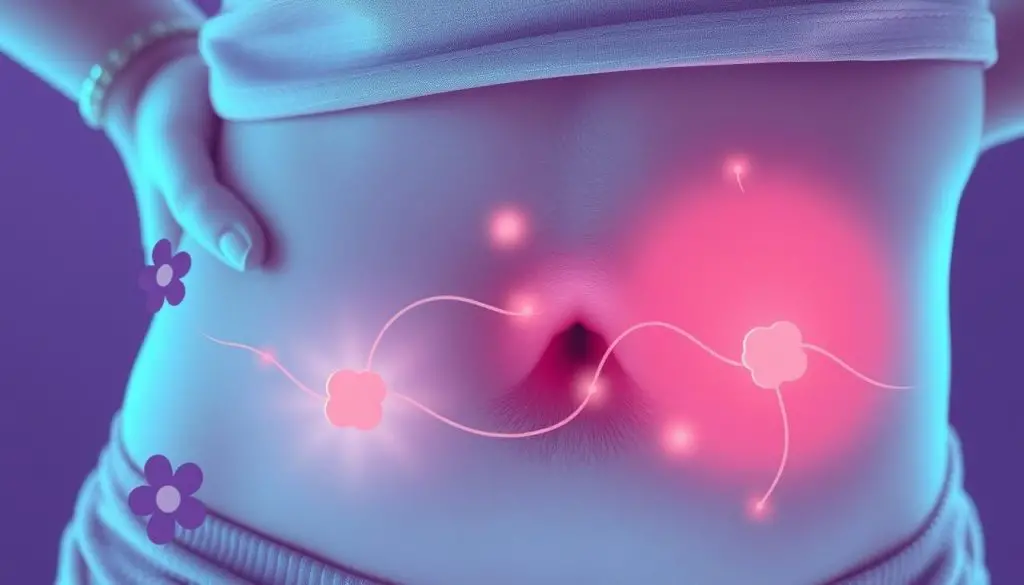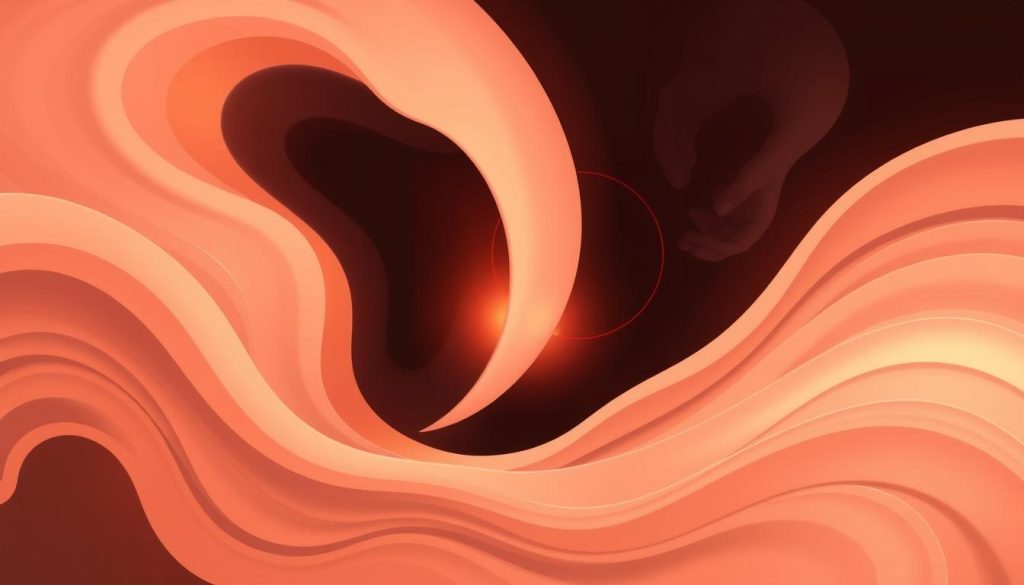Do your menstrual cramps leave you curled up in pain, struggling to find relief? While some discomfort during your period is common, could it be a sign of a more underlying condition like endometriosis? Endometriosis is a complex disorder where tissue similar to the uterine lining starts growing outside the uterus. This leads to severe pelvic pain, heavy bleeding, and other debilitating symptoms.
Understanding the connection between your menstrual pain and endometriosis could be the key to finding effective treatment. It could help you regain control over your reproductive health.
Endometriosis affects approximately 10% of women of reproductive age. It’s a relatively common yet often misunderstood condition. If you’re experiencing cramps that are significantly more painful or last longer than a typical period, it’s essential to consult your healthcare provider.
Exploring the possibility of endometriosis is important. Don’t resign yourself to excruciating menstrual pain. There are treatments and management strategies available to help you find relief.
Understanding Endometriosis
Endometriosis is a complex condition where tissue like the uterus lining grows outside the uterus. This tissue often grows on the pelvic tissue, ovaries, and fallopian tubes. During the menstrual cycle, this tissue breaks down, causing pain, inflammation, swelling, and scarring.
What is endometriosis and how does it develop?
The exact cause of endometriosis is not fully known. Researchers think several factors might contribute to it. These include:
- Retrograde menstruation: When menstrual blood and tissue flow backwards through the fallopian tubes and into the pelvic cavity instead of out of the body.
- Immune system conditions: Endometriosis may be linked to an overactive immune response that allows the endometrial tissue to implant and grow outside the uterus.
- Hormonal imbalances: Estrogen dominance and other hormonal irregularities may play a role in the growth and persistence of endometrial implants.
Endometriosis often affects women in their 30s and 40s. The chronic pain and other symptoms may lead to negative thoughts and self-harming behaviors in some.
Understanding endometriosis is key to recognizing it, seeking medical care, and managing symptoms effectively.
Painful Periods: A Common Symptom
Debilitating menstrual pain, or dysmenorrhea, is a common symptom of endometriosis. Women with endometriosis often face severe pelvic pain that can interfere with their daily lives. This pain may start a few days before their period and last through the whole menstrual cycle.
They may also experience heavy menstrual bleeding, adding to their discomfort.
While period cramps are common, those with endometriosis face more severe and lasting dysmenorrhea. This intense pelvic pain is a main reason they seek medical help. It’s key to understand the link between endometriosis and menstrual pain to offer the right treatment.
If you’re dealing with severe menstrual pain, see a healthcare provider. They can do a detailed check-up, including a pelvic exam and tests, to find the cause. With the right care, people with endometriosis can find relief and live better lives.
Menstrual Pain: The Key Connection
Many women suffer from severe menstrual pain, often tied to endometriosis. This condition happens when tissue like the uterus lining grows outside the uterus. This misplaced tissue can cause irritation, leading to pelvic pain.
The pain’s severity doesn’t always match the condition’s extent. Some women with mild endometriosis may feel extreme pain. Others with more endometriosis might feel less pain. This shows how complex and varied endometriosis can be.
Knowing the link between menstrual pain and endometriosis is key. It helps in getting an early diagnosis and better treatment. Recognizing symptoms can lead to seeking medical help and easing pelvic pain.
| Statistic | Value |
|---|---|
| Endometriosis Occurrence | Approximately 10% of women of reproductive age are affected by endometriosis. |
| Adenomyosis Prevalence | Adenomyosis is found to coexist in 20-40% of women with endometriosis. |
| Impact on Fertility | Endometriosis affects around 30-50% of women experiencing infertility. |
| Symptom Severity | Severe menstrual pain, known as dysmenorrhea, is reported in around 70-90% of women with endometriosis. |
Understanding the link between menstrual pain and endometriosis helps manage the condition. Early medical care, exploring treatments, and self-care can greatly improve life with endometriosis.
Endometriosis and Chronic Pelvic Pain
Endometriosis is more than just painful periods. It can cause pelvic discomfort and chronic pelvic pain too. The growth of endometrial-like tissue outside the uterus leads to irritation and scarring. This causes ongoing pain in the pelvic area, even when not menstruating.
Research shows that 24 percent (range 4 percent to 82 percent) of women with pelvic pain have endometriosis. Among women not showing symptoms but undergoing laparoscopic procedures, the rate is 4 percent (range of 1 percent to 20 percent). Women seeking infertility treatment are diagnosed with endometriosis at a rate of 20 percent (range of 2 percent to 78 percent).
The pain from endometriosis can be severe. It can make daily activities, work, and life quality hard. Knowing the link between endometriosis and chronic pelvic pain is key to finding the right treatment and managing symptoms.

Exploring the Link Between Endometriosis and Persistent Pelvic Discomfort
The cause of endometriosis is thought to be linked to several factors. These include retrograde menstruation, cellular metaplasia, and stem cell involvement. As endometrial-like tissue grows outside the uterus, it causes inflammation and scarring. This leads to ongoing pelvic discomfort and chronic pelvic pain.
The immune system changes in endometriosis also play a role in pain. The presence of activated peritoneal macrophages and cytokines worsens the pelvic inflammatory response.
It’s important to recognize the link between endometriosis and chronic pelvic pain. This helps in getting a timely diagnosis and effective treatment. Understanding the causes and addressing them can help alleviate symptoms and improve life quality.
Dyspareunia: Painful Intercourse
Endometriosis is a serious reproductive disorder that affects a woman’s sexual health. It often causes painful intercourse, known as dyspareunia. This pain happens when endometrial-like tissue grows in places like behind the uterus. It gets irritated during sex, causing pain.
Dyspareunia can really hurt a woman’s sexual well-being and her relationships. About 11% of women in the reproductive age group face this issue because of endometriosis. Treating dyspareunia is key to managing endometriosis and improving a woman’s life.
| Cause of Dyspareunia | Percentage of Cases |
|---|---|
| Vaginal dryness | 22% |
| Muscle spasms around the vagina | 8% |
| Abnormalities inside the uterus | 16% |
| Scar tissue outside the uterus (endometriosis) | 6% |
| Pelvic inflammatory disease | 4% |
Endometriosis is a big reason for painful intercourse, but other things can cause it too. Infections, diseases, and problems with the stomach or bladder can lead to dyspareunia. Even things like bad hygiene or sports injuries can cause vaginal inflammation and pain during sex.
Women with dyspareunia need to see a doctor. They might get medicine, hormone therapy, physical therapy, or surgery. With the right treatment, women can feel better and enjoy sex without pain.
Ovarian Cysts and Endometriosis
Endometriosis is a chronic condition that can lead to ovarian cysts called endometriomas or “chocolate cysts.” These cysts form when endometrial-like tissue grows on the ovaries. They can grow large and painful, sometimes needing surgery to remove.
The Role of Endometriomas in Endometriosis Diagnosis
Endometriomas are a key sign of endometriosis. They are a hallmark of the condition and help doctors confirm it through imaging or surgery. About 17 to 44% of women with endometriosis have endometriomas.
Endometriosis affects 2 to 10 percent of American women aged 25 to 40. It also affects up to 10 percent of women aged 15 to 44. Interestingly, about 17% of women with fertility issues have endometriomas.
The growth of endometriomas is similar to endometriosis. Hormonal responses cause inflammation and tissue growth. Doctors usually need surgery to diagnose endometriomas.
Women with symptomatic endometriosis face many challenges. They often have heavy or painful periods, chronic pelvic pain, and pain during sex. Endometriomas can make these symptoms worse, sometimes leading to emergency surgery if they rupture.
Researchers are studying what causes endometriomas. But, they know that certain factors increase the risk of endometriosis. These include never having children, starting menstruation early, and having a low BMI. Women with endometriosis also face a higher risk of certain ovarian cancers, though the risk is low.
Infertility and Endometriosis: The Relationship
Endometriosis is when endometrial tissue grows outside the uterus. It can greatly affect a woman’s ability to get pregnant. About 25% to 50% of women with infertility have this condition. It can cause infertility by scarring the fallopian tubes and affecting egg quality.
Studies show that women with unexplained infertility take longer to conceive than those with minor endometriosis. Also, treatments for endometriosis-related infertility vary, making personalized care key.
Research into endometriosis has found links to immune system issues. It may affect how the body fights off its own endometrium. The role of certain proteins in endometriosis and infertility is also being studied.
Genetic studies have found that endometriosis can run in families. This may explain why some women are more prone to it and infertility. Research on endometrium from women with endometriosis has identified genes linked to infertility.
In summary, endometriosis and infertility are closely linked. The condition affects fertility in many ways. Understanding this connection is vital for women with endometriosis who want to conceive. It helps guide treatment and management of this complex condition.
Menstrual Pain: Beyond Endometriosis
While endometriosis is a common cause of severe menstrual pain, it’s not the only reason for bad period cramps. Other issues like uterine fibroids, adenomyosis, pelvic inflammatory disease, and certain reproductive organ problems can also cause a lot of menstrual discomfort.
Women with severe menstrual pain should get a medical check-up to find out why and get the right treatment. This might include medicine, physical therapy, or sometimes surgery to fix the problem.
Exploring Other Possible Causes of Severe Menstrual Cramps
While endometriosis is known for causing bad menstrual pain, it’s not the only thing that can. Other possible causes include:
- Uterine fibroids: Noncancerous growths in the uterus that can cause heavy, painful periods
- Adenomyosis: A condition where the uterine lining grows into the uterine muscle, leading to heavy, painful periods
- Pelvic inflammatory disease: An infection of the female reproductive organs that can cause pelvic pain and cramping
- Structural abnormalities: Congenital or acquired issues with the shape or position of the reproductive organs
Getting a full medical check-up is key to figuring out why you have severe menstrual pain and finding the best treatment. This might include tests, pelvic exams, and sometimes surgery called laparoscopy to confirm the diagnosis.
| Condition | Symptoms | Treatment Options |
|---|---|---|
| Uterine Fibroids | Heavy, painful periods, pelvic pressure, frequent urination | Pain medication, hormone therapy, myomectomy (fibroid removal), hysterectomy |
| Adenomyosis | Severe, prolonged menstrual cramps, heavy periods, pelvic pain | Pain medication, hormone therapy, hysterectomy |
| Pelvic Inflammatory Disease | Pelvic pain, fever, abnormal vaginal discharge, painful intercourse | Antibiotics, anti-inflammatory medication, removal of infected tissue (in severe cases) |

It’s important to find and treat the real cause of severe menstrual pain to manage it well and improve life quality. By working with a healthcare provider, women can explore different treatments and find what works best for them.
Diagnosing Endometriosis
Diagnosing endometriosis is tricky because its symptoms can look like other health issues. A pelvic exam, ultrasound, and MRI can give some clues. But, the only sure way to know if you have endometriosis is through a laparoscopy.
The Importance of Laparoscopy
A laparoscopy uses a small camera through a tiny cut in your belly. This lets the doctor see your pelvic organs and take a tissue sample. It’s the best way to find out if you have endometriosis.
Recent studies say laparoscopy is the only sure way to diagnose endometriosis. It shows where, how big, and how deep the lesions are. This info helps doctors choose the right treatment.
It’s also key to know that endometriosis often goes with adenomyosis in 80 to 90% of cases. Deep-infiltrating endometriosis can sometimes be seen on ultrasound or MRI.
Even though endometriosis can make it hard to get pregnant, most women can have kids without problems. Laparoscopic surgery can even help women with endometriosis get pregnant more easily.
If you think you might have endometriosis, see a doctor who knows a lot about it. They can help figure out what’s going on and make a plan just for you.
Conservative Treatment Options
Women with endometriosis often start with conservative treatments first. These methods aim to ease menstrual pain and pelvic discomfort. They also try to control the growth and shedding of endometrial-like tissue.
Over-the-counter pain medications, like ibuprofen, can help with cramps and pelvic pain. These anti-inflammatory medications reduce inflammation, which helps ease the pain.
Hormonal therapies, including birth control pills, are also helpful. They regulate hormonal changes that cause the growth and breakdown of endometrial tissue. This helps reduce pain and symptoms.
Other conservative treatment options can also offer relief. These include heat therapy, dietary changes, and relaxation exercises. By using a mix of these methods, many women can manage their endometriosis-related pain better and live a better life.
| Treatment Option | Effectiveness | Key Benefits |
|---|---|---|
| Over-the-Counter Pain Medications | Between 17% and 95% of women achieve pain relief | Reduces inflammation and cramps |
| Hormonal Therapy (Birth Control Pills) | 65% of women experience relief from dysmenorrhea | Controls hormonal fluctuations and endometrial growth |
| Physiotherapy Techniques | Significant reduction in menstrual pain intensity | Non-invasive, no side effects |

Surgical Intervention for Endometriosis
When treatments like hormonal therapy don’t work, surgery might be needed. This is true if endometriosis is causing infertility or other serious problems. A laparoscopy is often used. It lets the surgeon see inside the pelvis, remove endometrial implants, and take a biopsy.
For severe cases, more surgery might be needed. This could include removing endometriosis lesions or endometriomas. Studies show that surgery can help by removing implants and scar tissue. It’s also needed when endometriosis affects other organs.
When is Surgery Recommended for Endometriosis Management?
Laparoscopic surgery is done through small cuts and has a quick recovery time. It usually takes 10 to 14 days to heal. In some cases, removing the uterus might be suggested. But, this means you won’t have periods anymore and could face menopause symptoms.
Research says laparoscopic surgery can cure endometriosis in up to 70% of women. Removing the uterus can cure it in over 90% of women. But, about 30% of women might see endometriosis come back after surgery.
If you’re thinking about surgery for endometriosis, talk to your doctor. Understand the good and bad sides of each surgery option.
Lifestyle Changes for Menstrual Pain Relief
If you’re dealing with endometriosis or menstrual pain, making lifestyle changes can help. Regular exercise releases endorphins, boosting your mood and health. Taking a warm bath or using a heating pad on your lower abdomen can also ease cramps.
Changing your diet can also help. Cutting down on processed foods and dairy might make your symptoms better. Research shows that eating more plant-based foods and less animal products can reduce pain and PMS symptoms.
While these changes won’t cure endometriosis or get rid of all pain, they can help. By focusing on your health, you can manage your symptoms better and live a better life.
Embrace Exercise and Heat Therapy
- Regular exercise can help release endorphins and improve your overall well-being.
- Applying a heating pad or taking a warm bath can provide soothing relief for menstrual cramps.
Adjust Your Diet
- Reduce your intake of processed foods and dairy products.
- Increase your consumption of plant-based foods, such as vegetables, fruits, and whole grains.
- Consider incorporating more omega-3 fatty acids, which can help reduce inflammation.

Remember, these lifestyle changes aren’t a complete fix, but they’re a great addition to your pain management plan. By focusing on your well-being and trying different approaches, you can find relief and improve your life.
Seeking Support for Endometriosis
Living with endometriosis can be tough. The pain, complications, and emotional strain are hard to handle alone. But, you don’t have to face it by yourself. Getting support from others who get it can be a big help.
The Role of Support Groups and Resources
Joining an endometriosis support group can be a game-changer. You can share your story, learn new ways to cope, and feel less alone. These groups offer valuable info, advice, and a sense of community.
There are also many organizations and resources out there. They provide info, support, and advocacy for women with endometriosis. You can find websites, social media groups, and clinics that specialize in the condition.
By connecting with these support networks, you can learn a lot and feel empowered. Remember, you’re not alone. There are people and resources ready to help you through this.
Meeting others who understand can change your life. Take time to look into the endometriosis support groups and resources out there. Don’t be afraid to ask for help and support to manage your condition well.
Endometriosis and Menstrual Pain: Key Takeaways
Endometriosis and menstrual pain are closely linked but complex. This condition causes the uterine lining to grow outside the uterus. It leads to severe pelvic pain, often during your periods. But, not all severe menstrual cramps are due to endometriosis.
If you’re dealing with ongoing or worsening menstrual pain, getting medical help is key. Endometriosis can cause more than just painful periods. It can also lead to painful sex, ovarian cysts, and infertility. The right treatment can help ease symptoms and improve your life quality.
Endometriosis affects about 10% of women, so you’re not alone. With the right care and support, you can manage the condition. Stay informed, advocate for your health, and work with your healthcare provider to find the best treatment for you.
Source Links
- https://www.mayoclinic.org/diseases-conditions/endometriosis/symptoms-causes/syc-20354656
- https://nyulangone.org/news/endometriosis-six-symptoms-you-should-never-ignore
- https://www.webmd.com/women/endometriosis/understanding-endometriosis-symptoms
- https://www.topdoctors.co.uk/medical-articles/know-difference-between-regular-period-pain-endometriosis
- https://www.obgynassociatesmarietta.com/blog/normal-menstrual-cramps-or-endometriosis-how-to-tell-the-difference
- https://www.endofound.org/painful-periods
- https://www.hopkinsmedicine.org/health/conditions-and-diseases/dysmenorrhea
- https://medlineplus.gov/periodpain.html
- https://www.webmd.com/women/menstrual-pain
- https://www.acog.org/womens-health/faqs/dysmenorrhea-painful-periods
- https://www.ncbi.nlm.nih.gov/books/NBK279324/
- https://www.ncbi.nlm.nih.gov/pmc/articles/PMC3096669/
- https://www.who.int/news-room/fact-sheets/detail/endometriosis
- https://familydoctor.org/condition/dyspareunia/
- https://www.advancedgynecology.com/conditions-symptoms/dyspareunia
- https://www.ncbi.nlm.nih.gov/books/NBK562159/
- https://www.ncbi.nlm.nih.gov/books/NBK559230/
- https://www.hopkinsmedicine.org/health/conditions-and-diseases/endometriosis
- https://www.ncbi.nlm.nih.gov/pmc/articles/PMC2941592/
- https://www.ncbi.nlm.nih.gov/pmc/articles/PMC3538128/
- https://www.ohsu.edu/womens-health/severe-menstrual-pain-not-normal
- https://www.whmg.net/endometriosis/beyond-period-pain-exploring-the-impact-of-endometriosis
- https://www.mayoclinic.org/diseases-conditions/endometriosis/diagnosis-treatment/drc-20354661
- https://www.aafp.org/pubs/afp/issues/1999/1015/p1753.html
- https://www.brighamandwomens.org/obgyn/infertility-reproductive-surgery/endometriosis/endometriosis-symptoms
- https://www.ncbi.nlm.nih.gov/pmc/articles/PMC1459624/
- https://www.ncbi.nlm.nih.gov/pmc/articles/PMC8345570/
- https://emedicine.medscape.com/article/253812-treatment
- https://nyulangone.org/conditions/endometriosis/treatments/surgical-treatment-for-endometriosis
- https://www.thewomens.org.au/health-information/periods/endometriosis/treating-endometriosis
- https://www.houstonmethodist.org/blog/articles/2021/sep/menstrual-cramps-5-tips-for-getting-relief-from-period-pain/
- https://www.thewomens.org.au/health-information/periods/healthy-periods/exercise-diet-periods
- https://healthmatters.nyp.org/what-to-eat-during-your-period-foods-that-help-reduce-cramps-and-foods-to-avoid/
- https://www.newhopefertility.com/blog/coping-with-endometriosis/
- https://endometriosisassn.org/endometriosis-resources/teens/
- https://livehealthy.muhealth.org/stories/period-pain-6-surprising-facts-know-about-endometriosis
- https://www.womenshealth.gov/a-z-topics/endometriosis
- https://www.ncbi.nlm.nih.gov/pmc/articles/PMC7573391/
